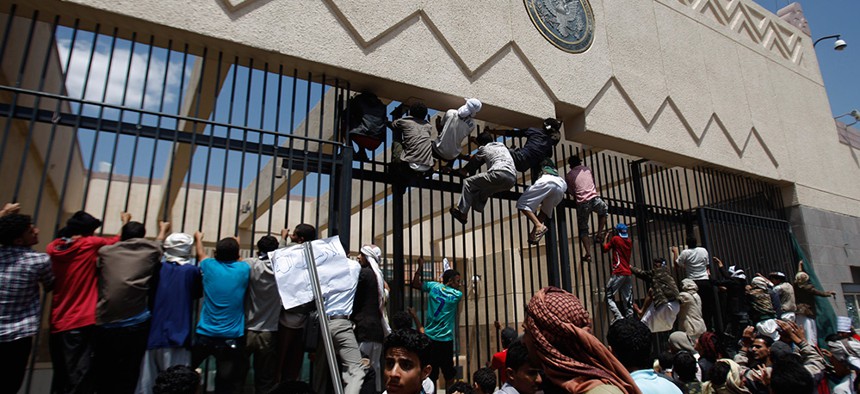A Brief, Turbulent History of the U.S. Embassy in Yemen
The compound, which has seen several terrorist threats in the recent past, will shut down this week for security reasons.
The American Embassy in Yemen is closing down this week amid political turmoil and a crumbling security situation in the region.
Embassy employees plan to shut down the U.S. mission in Yemen's capital city of Sana'a by Wednesday, and have been disposing of documents and weapons and leaving the area over the last few days, Reuters reported Tuesday.
The embassy, located in the capital city of Sana'a, was closed to the public last month as "a prudent precaution," according to U.S. officials cited by NBC News, after years of violenceamong various rebel groups within Yemen boiled over. Shiite Houthi rebels, based in the northern part of the country, overran Western-backed Yemeni President Abed Rabbo Mansour Hadi's palace on Jan. 20. Days later, Hadi and his entire Cabinet resigned, leaving the Houthis effectively in control of the Yemeni government.
Several months before that happened, the U.S. Embassy sent nonessential staff home.
Matthew Tueller, the U.S. ambassador to Yemen, has reportedly told employees that the Obama administration may ask the Turkish or Algerian embassies in Sana'a to look after U.S. interests in Yemen. Tueller, who was appointed last May, has appeared calm in the face of the collapse of Yemen's government. "As long as he can operate there, he will want to," Ryan Crocker, a former top U.S. diplomat who worked with Tueller, told Politico last month. "He personifies one of my mantras for service in the Middle East: Don't panic."
But embassy employees have had reason to panic before.
In June 2001, Yemeni authorities arrested eight Yemenis believed to be plotting to blow up the building. In 2008, Qaida affiliated terrorists detonated a car bomb near the embassy's security gate and tried to storm the compound. The attack killed 16 Yemeni police and civilians and six assailants. In 2009, three gunmen opened fire at a checkpoint outside the embassy. They were quickly apprehended, and no one was injured.
The United States first established diplomatic relations with Yemen in 1946, sending two diplomats to lead the American mission there in the city of Taiz. In 1963, the mission was elevated to embassy status, but there was no U.S. ambassador until 1967, after the mission had relocated to Sana'a. Yemen temporarily severed ties with the U.S. that year during the Arab-Israeli conflict. The U.S. established an embassy in Aden after relations were restored later that year, but it closed in 1969 amid disagreement between the two nations and never reopened. In 1972, the Sana'a embassy opened again, and William R. Crawford, Jr., became the first U.S. ambassador to Yemen to live there.
This week's closure means that the U.S. now does not have a functioning embassy in three Arab Spring countries: Yemen, Libya. and Syria.
NEXT STORY: GOP Awaits Obama's ISIS Battle Plan




